The Globe's Newspaper Mailing BookletGray Scrimgeour
This note describes a postal history artifact found in the summer of 2007 -- a rare newspaper mailing booklet that was used from 1895 to 1897 by The Toronto Globe newspaper. Arfken and Pawluk [1] have described the process and rates for mailing of newspapers. In the 1890s, newspapers printed and published in Canada mailed at the place of publication and addressed to regular subscribers in Canada, the United States, and Newfoundland were transmitted free of postage, except in cities having a Letter Carrier system. In the latter case, 1¢ per 4 ounces was charged. A bulk-rate charge of 1¢ per pound applied to specimens or sample copies of newspapers from the office of publication. After the receiving postal clerk had weighed the newspapers, this charge was paid by affixing postage stamps in a special payment book. Arfken and Pawluk show cover pages -- bearing the regulations -- from one of these payment books and also pages recording mailing of 30, 50, and 180 pounds of papers. The use of these payment books ceased on July 1, 1901. Very few intact booklets have been found or exist, and to my knowledge there are no others with as many high-value frankings as The Globe's booklet. 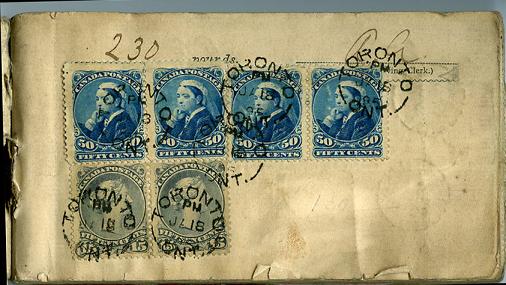
Figure 1. First page of the newspaper-postage booklet The printing on the cover pages of the 100-page Globe book is similar to that shown as Figures 135 and 136 in Arfken and Pawluk, except that the printing number is 39P.M.--300-7-5-94. Printed in pencil on the outside of the cardboard cover is, 'Toronto Globe / Mailing Book / July 18th to Aug. 17th / 1897.' The first page with stamps, though, is dated over two years earlier, January 18, 1895 (Figure 1). Mailing of 230 pounds of newspapers was paid for with four 50¢ Widow Weeds and two 15¢ Large Queens. Pages 2 and 3 show that another 33 pounds of papers were mailed on January 18. The next large mailing (pages 15 through 23, May 21, 1895) was 5,000 pounds. Each 50 pounds was paid with a 50¢ Widow Weed stamp; 600 pounds per page were paid by 12 stamps. 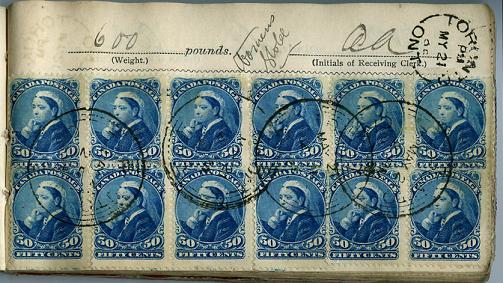
Figure 2. Page 15 of the booklet, May 21, 1895 Figure 2 illustrates page 15, with twelve 50¢ Weed adhesives cancelled by an orb and the page dated with a broken circle. The manuscript 'Womens Globe' on the page probably indicates why there was an extra mailing. 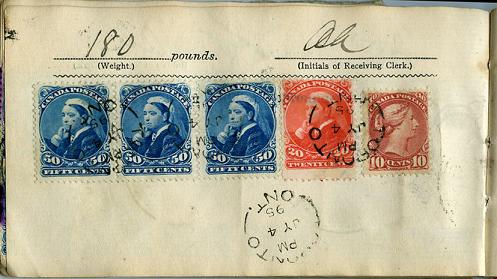
Figure 3. Page for July 4, 1895, with 180 pounds mailed On July 4, 1895, 180 pounds of papers were mailed, with payment using three 50¢ Weeds, a 20¢ Weed, and a 10¢ Small Queen (Figure 3). There are fairly heavy mailings on February 17 (343 pounds) and March 3, 1897 (872 pounds). 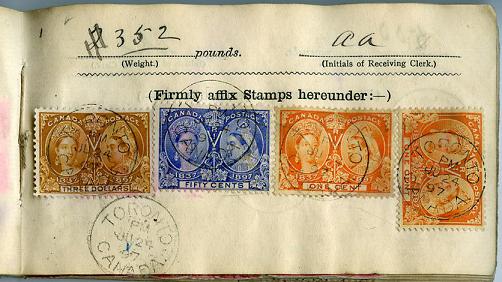
Figure 4. Postage of $3.52 paid on June 24, 1897 with Jubilee adhesives The most exciting section of the book starts on page 51. Pages 51 to 70 are all dated June 24, 1897. The Jubilee stamps had been issued only five days earlier. Page 51 (Figure 4) shows the postage paid for 352 pounds of papers; the stamps used were a $3, a 50¢, and two 1¢ Jubilees. Several pages used a single $5 Jubilee adhesive to pay for mailing of 500 pounds of papers. Single pages dated June 24 had stamps paying for up to 565 pounds. 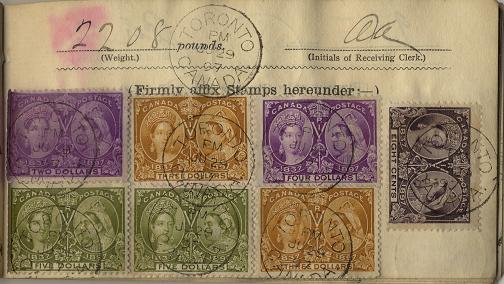
Figure 5. Postage of $22.08 paid with Jubilee stamps; a gem The booklet records a total of 8,877 pounds being mailed on June 24. On June 29, though, there is a single page recording payment for 2,208 pounds of newspapers (Figure 5). The stamps used were two $5, one $4, two $3, one $2, and one 8¢, adding up to the correct postage of $22.08. Three other pages were used on June 29 for 915, 41, and 29 pounds, respectively. 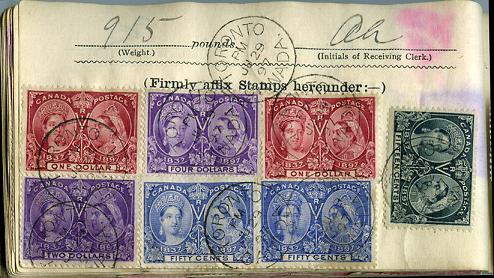
Figure 6. Reverse of the page shown in Figure 5 The 915-pound page (page 82, the back of the 2,208-pound page) is particularly attractive, with a $4, a $2, two $1, two 50¢, and a 15¢ stamp (Figure 6). On August 6, there was another heavy mailing, which included five pages of 250 pounds each. These were paid with vertical strips of five 50¢ Jubilees. The final pages, 75 to 100, were used in August 1897 and the final date is August 17, 1897. I have tried to match the dates of heavy mailing with special issues or features of The Globe, issues that would be bought by non-subscribers. The January 18, 1895 mailing probably involved copies of the 'Pictorial Story of Our Country As it Was and Is', a compilation of 41 serialized articles entitled 'Picturesque Canada' about different regions and cities in Canada. This book was advertised in the January 4, 1895 issue, for sale 'for the phenomenally low price of Five Dollars'. I cannot find a reason for the May 21, 1895 mailing, unless it was a Saturday May 18 article about Catherine Parr Traill. Nor could I find a reason for the heavy mailing on July 4, 1895. The February 17, 1897 heavy mailing possibly was of a February 6 Globe issue with a 16-page supplement about Rossland, BC's mines. 
Figure 7. Advertisement for The Jubilee Globe from the May 17, 1897 issue of the Toronto Globe In June 1897, The Globe published a special Jubilee Globe, to be issued with the regular June 9 paper (see the May 17 advertisement for this issue, Figure 7). Regular subscribers received a free copy of the 28-page special paper. The newspaper soon announced that the first edition of the Jubilee Globe, in press in late May, was exhausted and that a second edition would go to press on June 4. By early June, the newspaper was advertising a third edition. The cost of the Jubilee number was 15¢, 20¢ if mailed to Canada or the US, 25¢ if mailed to Great Britain. For 40¢ (if mailed), one could buy both a copy of the special newspaper and a 21 x 28-inch, 14-coloured Medallion Picture of Her Most Gracious Majesty. The heavy summer 1897 mailings recorded in the booklet undoubtedly reflect purchases by nonsubscribers of the special Jubilee editions of the Globe. Although the condition of the booklet shows it was carried to the post office numerous times, most of the stamps are in good shape. A few stamps are not attached on one edge. Single stamps are missing from seven pages. They appear to be a 20¢ Jubilee, a 50¢ Jubilee, a $1 Jubilee, two $2 Jubilees, a $4 Jubilee, and a $5 Jubilee. The 20¢ Jubilee missing from page 82 was loose in the book (found a few pages later). The deceased owner probably removed the missing high-value stamps and put them on his album page, or traded or sold them. For all of the other pages, the adhesives present tally with the weights listed. For reference, a complete set of scans of the booklet--as it was found--appears on this web site. Each scan shows two pages of the booklet. The postmarks used in this booklet do not include the roller cancels often seen on high-value Jubilees used in Toronto. Postmarks used were TORONTO / ONT. and TORONTO / CANADA broken circles, two- and three-ring orbs, squared circle, Enquiry Office oval, and full-circle date stamps. The finding of this booklet with its high-value Jubilee stamps is a major philatelic event. The commercial usages of the dollar values show that -- however infrequently -- these commemorative stamps did find proper use. Links to booklet pages:Part 1 Part 2 Part 3 Part 4 References: 1. Arfken, G.B. and Pawluk, W.S. A Canadian Postal History 1897-1911. Ottawa, British North America Philatelic Society Ltd., 2006, pp. 104-107. |
Benefits of Membership
» What's new! Utilities
» PHSC Symposium |










